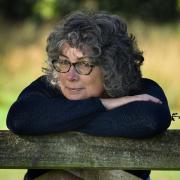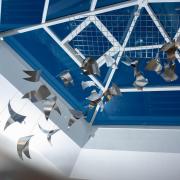A newly available photographic collection brings into fresh focus one of Sussex’s most extraordinary women: sculptor, journalist, traveller and writer, Clare Sheridan (1885-1970)
‘As a human being she must rank as unique’, wrote The Times in Clare Sheridan’s obituary. Looking through her personal photographic collection, recently digitised and now available to view at Brighton’s the Keep archive, it’s hard to disagree. The tall, blonde and striking Sheridan, is shown relaxing at her family home in Brede, East Sussex, one moment and then exploring the Sahara Desert the next. In some images she appears in elegant evening dress, while in others she wears an Arabian hooded-cloak, Native American buckskins, or work clothes splattered with clay or plaster of Paris. This is a record of a breathless life, of a singular woman who not only produced portrait busts of many leading figures of the 20th century – Winston Churchill, Lenin, Charlie Chaplin, and Gandhi, among them – but who also became a famous war correspondent, and best-selling writer; a woman who defied the conventions of her age.
The 19 folders of photographs progress chronologically from around 1910 to the 1940s. The sequence starts off in typical Edwardian fashion. There are lots of black-and-white images of babies in prams, stiff-looking friends and family, and children posing in gardens like ornaments. Men in uniform suddenly appear among the gatherings, the only indication that the First World War had begun. Clare Sheridan’s husband, Wilfred, is one of them - a man with a robust physique and bushy moustache. They had married in 1910 after falling in love at first sight. Both were from aristocratic families but neither had much money. They eventually had three children together, Margaret, Elizabeth (who sadly died in infancy died in February 1914), and Dick. There is a poignancy to the last photograph in which husband and wife are shown together. Days after it was taken, in September 1915, Wilfred was killed in the Battle of Loos.

There is another early image that provides some foretelling of Sheridan’s future. It depicts a small terracotta angel that she made to adorn the memorial of her daughter Elizabeth. It marked the awakening of her artistic talent. Widowed, with two small children to support, she did not marry again but turned to sculpture as a means to make her own way in the world.
Installed in a studio in London’s St John’s Wood, Sheridan studied and worked at this new discipline. Busts of the former Prime Minister Herbert Asquith, author H.G. Wells, and her cousin Winston Churchill, were among her first works. But her big break came in 1920, when she was struck by the rugged face of a visiting Russian trade delegate. An approach to make his portrait turned into an invitation to visit Bolshevik Moscow and to sculpt Lenin and Trotsky. It was a potentially dangerous and inflammatory opportunity, but Sheridan, like her cousin Winston, was willing to take the risk in order to make a name for herself. She subsequently spent hours alone with both individuals. Lenin mostly remained consumed by his work, but once engaged in some small-talk, commenting, ‘Your cousin, Monsieur Churchill, he must be pleased with you!’ Trotsky took more interest in this brave and beautiful sculptor working at his side and became infatuated with her.

Sheridan returned to a media storm in the UK. Reporters and newspapers clamoured for details about her impressions and adventures. She wrote about both in a series of articles for The Times. She used to enjoy seeing the placards advertising the story: ‘With Lenin and Trotsky. Diary of an Englishwoman.’ And often boarded morning buses and the Tube to see city clerks reading them. London Society, however, disagreed with her actions and sympathetic views on the Bolsheviks. They shunned her and sculptural commissions dried-up. She decided, therefore, to accept an offer from the New York Times to lecture in the US. While abroad, her dinner-time conversation became infamous. On one occasion she shared her difficulty in understanding why women had to depend on men: ‘it was a woman’s privilege to bear a child to the lover of her choice and the State should support her financially’ she reasoned. ‘It was ignominious to have to marry a man and pin him down for money before you dared breed.’ The ladies sat in silent horror listening to her argument while the men stared at their dinner plates. At other times people looked on in astonishment as Sheridan marched down Fifth Avenue in a fur-lined coat and Russian boots, looking like a Cossack. In Charlie Chaplin, however, she met a kindred spirit, and they spent a week together in a secluded grove on the Californian coast, causing a scandal in the world’s newspapers. Then came another career opportunity. The foreign editor of the New York World, Herbert Swope, commissioned her to return to Europe as a journalist and report on post-war events. The result was scoop after scoop, with Sheridan often able to gain exclusive interviews with key leaders. These included the Irishmen and IRA leaders Michael Collins and Rory O’Connor, as well as Kemal Atatürk, founder and first president of Turkey, and Italian fascist leader ‘Duce’ Benito Mussolini, whom she called ‘a grotesque tyrant in white spats.’

Later, tiring of journalism, she settled in Istanbul and then at the oasis town of Biskra in Algeria, where she built a house among the date-palms. The photographs from this episode are some of the most interesting and romantic. They show lonely vistas of the Sahara, camel trains, Roman ruins, local Arabs, and the shimmering white façade of the Sheridan villa, known to friends as ‘The House of a Thousand and One Nights’. One of the folders dated to the mid-1930s has several photographs of her son, Dick. By this time, he had grown into a strapping young man. He is shown aboard his boat with beaming smile and wind-tousled hair, or sitting with his mother in a smart white-linen suit. But, tragically, they are followed by a series of images of the desolate harbour-village of Port Vendres, on the French/Spanish border, and a freshly covered grave. It was here that Dick, aged just 21, was buried after dying of appendicitis in 1937. Sheridan was never quite the same again. She found solace in her art once more, this time learning to carve in wood which she believed had greater sensation and expression. Up to this point, she had considered herself a modeller rather than a true sculptor. ‘How strange’, she wrote in her 1957 memoir To the Four Winds ‘that through losing one child, I discovered myself as a modeller; through losing another, I found myself as a carver.’
Much of this new work began in America, where Sheridan joined an art colony in the Rocky Mountains. During the trip she met several Native American individuals, some of whom she sculpted. Her kindness, curiosity and willingness to live as they did, earned her their lasting friendship and respect. She was even accepted into the Blackfeet tribe, and given a new name, Kototos-aki or Star-woman. Two of the collection’s folders are stuffed with memorable images from this experience, recording native ceremonies, dances, and ways of life, as well as Sheridan’s early carvings and the antics of her pet bear, Kyaiou. She continued to work with wood on her return to the UK, and produced many religious sculptures which are arguably her best-known works today. One depicting the Madonna with child, a memorial to her son Dick, can still be seen in Brede’s St George’s Church.

The photographic collection comes to an end shortly after the Second World War. Her life, however, went on. She moved to Ireland for a time, and then Hastings, where she lived in the eccentric Belmont House. A blue plaque now hangs on the wall to commemorate her stay. In Assisi, she fulfilled a lifelong desire and converted to Catholicism, and she was later blessed by the Pope in Rome. She passed away in May 1970 and was buried in Brede’s churchyard, close to her son’s memorial.
There is the hope that more photographs, along with other items from her archive such as letters and drawings, will be made available in the future, perhaps revealing new stories about this extraordinary Sussex character. But for now, the Keep’s photographic collection in Brighton provides a fresh, vivid and intimate reminder of the trailblazing life of Clare Sheridan. A woman who Churchill described as that ‘wild cousin of mine.’
The Keep Archives is on Woollards Way, Brighton. thekeep.info




























